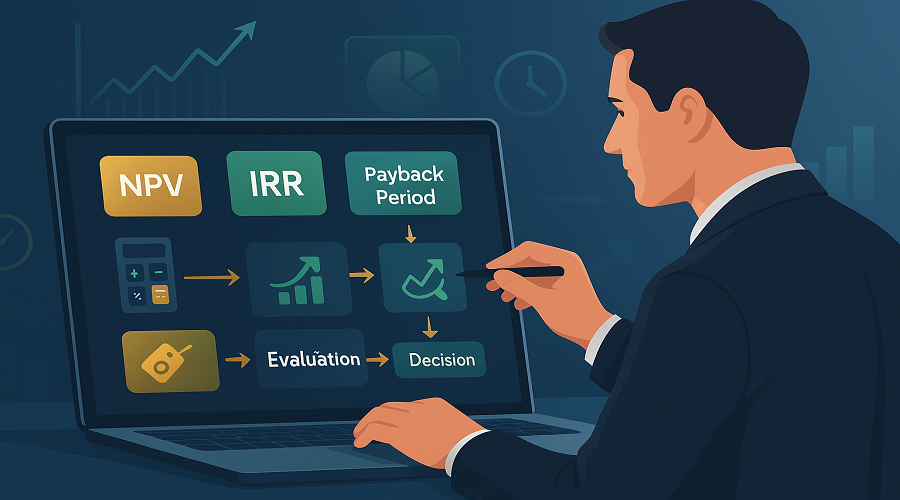Choosing the right investment isn’t just about intuition it’s about analysis. Capital budgeting methods: NPV, IRR, payback period and more help you evaluate projects with confidence. With real numbers, you can prioritise initiatives that maximize value, minimize risk, and align with your strategy. Whether you’re a CFO, financial analyst, or business owner making your first big investment, this guide breaks down the essentials in a clear, engaging way.
What Is Capital Budgeting and Why It Matters
Capital budgeting is the process of evaluating long-term investments like new equipment, product lines or expansion projects based on their expected financial returns. Using capital budgeting methods helps you:
- Compare opportunities using cash flow analysis
- Account for time value of money
- Optimize resource allocation
Without a proper method, you risk misallocating funds to projects that look promising but fail to deliver value or missing hidden winners with strong returns.
Net Present Value (NPV) - The Gold Standard
NPV calculates the present value of future cash flows minus the initial investment. It’s the purest measure of value creation:

- Why it matters: A positive NPV means the investment exceeds your desired return value added.
- Strengths: Incorporates time value of money and scale.
- Limitations: Requires reliable cash flow forecasts and an accurate discount rate.
Internal Rate of Return (IRR) - The Percentage Perspective
IRR is the discount rate that sets NPV to zero it’s the expected annual return of the project:
- Decision rule: Accept if IRR > your cost of capital.
- Strengths: Expressed as a percentage, easy to compare.
- Limitations: Can give multiple IRRs for unconventional cash flows; may mislead when comparing projects of different size or timing.
Payback Period - Quick and Simple
Payback period measures how long it takes to recover the initial investment:
Formula:
- Payback = Years to recover cost via cumulative cash flows.
- Strengths: Easy to grasp; useful for liquidity-focused decisions.
- Limitations: Ignores cash flows after payback and does not factor time value of money.
Discounted Payback Period - A Smarter Twist
This method improves the payback period by discounting cash flows:
- Advantage: Accounts for time value.
- Limitation: Still ignores cash flows beyond breakeven.
Profitability Index (PI) - Prioritising Projects
PI is the ratio of present value of returns to initial cost:
Formula:
PI = (PV of future cash flows) / (Initial Investment).
- Use case: Ideal when capital is constrained.
- Pros: Shows value per unit of investment.
- Cons: Doesn’t reveal total value smaller projects may outperform bigger ones in ratio terms.
When to Use Each Capital Budgeting Method
- NPV: Best for overall value and priority-based decisions.
- IRR: Useful for percentage-based comparisons but not standalone.
- Payback Period: Ideal for quick liquidity checks or simple screening.
- Discounted Payback: A middle-ground adds rigour to payback.
- Profitability Index: Helpful when ranking small projects under budget limits.
Pro Tip:
Always pair methods. If a project looks good by NPV and IRR, and pays back quickly, it’s likely a robust investment.
Common Pitfalls to Avoid
- Mixing methods without understanding their strengths can lead to wrong conclusions.
- Using poor discount rates, which skews NPV and IRR.
- Ignoring risk and flexibility real options, sensitivity analysis, and scenario planning matter too.
- Overloading on short-term metrics, trading value for speed or security.
Best Practices for Smooth Capital Budgeting
- Forecast conservative cash flows, including inflation and working capital.
- Select a realistic discount rate reflecting risk and opportunity cost.
- Conduct sensitivity analysis on key assumptions.
- Combine methods NPV for core decisioning, IRR for rates, payback for liquidity insights.
- Revisit budgets regularly; markets change, and so will project viability.
Final Takeaway
Capital budgeting methods: NPV, IRR, payback period and more are your toolkit for disciplined investing. When used correctly, you’ll differentiate between high-value initiatives and empty promises. Combine strategic methods, stay analytical, and make decisions backed by both numbers and insight.
If you are a researcher who feels stuck at any stage of your research journey, don’t hesitate to connect with us. Let us help you clear your doubts and make your research smoother.
FAQ
1. What is the best capital budgeting method?
No single method works for everything. NPV is most accurate for value, IRR helps compare rates of return, and payback checks liquidity quickly. Use them together.
2. Is IRR always reliable?
Not always. IRR can give conflicting signals when cash flows change sign more than once. Always check with NPV.
3. How does payback period help?
It tells you how fast you’ll recoup your investment helpful for cash flow planning but it ignores long-term profitability and time value.
4. What discount rate should I use?
Use your firm’s weighted average cost of capital (WACC). If the project is riskier, add a premium; if it reduces risk, you may use a lower rate.
5. Can I skip forecasting and go with simpler methods?
Short-term methods are ok for quick screening, but long-term decisions require solid forecasting. Accuracy drives success.





Comments